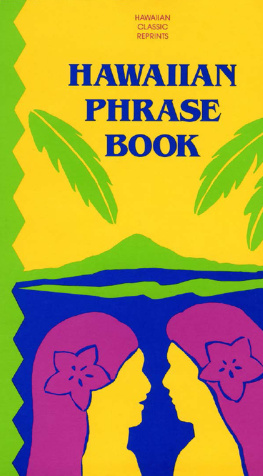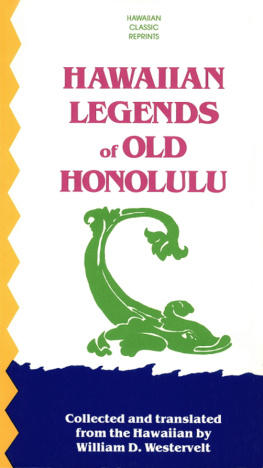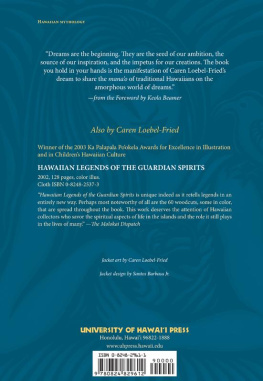Published by Kamehameha Publishing, a division of Kamehameha Schools
Copyright 2015 by the Native Hawaiian Legal Corporation and Ka Huli Ao Center for Excellence in Native Hawaiian Law
All rights reserved.
No part of this book may be reproduced in any form or by any electronic or mechanical means, including information storage and retrieval systems, without permission in writing from the publisher, except by a reviewer who may quote brief passages in a review.
Inquiries should be addressed to:
Kamehameha Publishing
567 South King Street
Honolulu, Hawaii 96813
www.kamehamehapublishing.org
ISBN 978-0-87336-344-0
Cover: A view from Moaula, at the summit of Kahoolawe.
Photo courtesy of Andrew Wright
Additional photography by Ruben Carillo

Editor-in-Chief
Melody Kapilialoha MacKenzie
Executive Editors
Susan K. Serrano
D. Kapuaala Sproat
Associate Editors
Ashley Kaiao Obrey
Avis Kuuipoleialoha Poai
CONTENTS
Melody Kapilialoha MacKenzie
Melody Kapilialoha MacKenzie
Koalani Laura Kaulukukui
Paul Nhoa Lucas, Alan T. Murakami, & Avis Kuuipoleialoha Poai
Melody Kapilialoha MacKenzie
Julian Aguon
Arnold L. Lum & Stephanie M. Chen
Arnold L. Lum & Stephanie M. Chen
D. Kapuaala Sproat
Alan T. Murakami & Wayne Chung Tanaka
D. Kapuaala Sproat & Jodi A. Higuchi
Melody Kapilialoha MacKenzie & Wayne Chung Tanaka
D. Kapuaala Sproat
David M. Forman & Susan K. Serrano
Melody Kapilialoha MacKenzie
Natasha L. N. Baldauf
Lea Malia Kanehe
N. Kanale Sadowski & K. Kaanoi Walk
Avis Kuuipoleialoha Poai & Susan K. Serrano
Kamanaonpalikhonua Souza & K. Kaanoi Walk
Amanda Lokelani Donlin Furman & Scott K. D. Shishido
FOREWORD
As we go to press, the voyaging canoes Hklea and Hikianalia are circumnavigating Earth using technologies both ancient and cutting-edge. Guided by stars and engaging our one world, one island via satellite, this exemplar of human potential stands in stark contrast to what is increasingly a new norm: catastrophic climatic events largely attributable to man-made global warming.
As our human population tilts past 7.2 billion, there is increasing awareness of our predicament as a threatened species on our one world, one island. In this circumstance, we believe it wise to listen and pay heed to Haumea, Mother Earth, who teaches us all things. From her we know that we should live peaceably as a world family and should honor the divine that is in us and in all creation. Her wisdom is an inexhaustible spring, a pnwai where we will always find refreshment, and answers.
This treatise, like the great voyages of Hklea and Hikianalia, has as its ambition no less than world peace predicated on ancient wisdomswisdoms not only instructive but critical to our survival as a species. It is our modest contribution to a grand enterprise. With these good works, like those of our great navigators, our intent is that our collective strivings and humankind will be fruitful, mau a mau, forever.
Mahealani Wendt
ADMINISTRATOR/EXECUTIVE DIRECTOR, 19782009
NATIVE HAWAIIAN LEGAL CORPORATION
Comprised of updated and new chapters, this scholarly work offers us pathways, informed by Lono and tempered by K, to pono. The character and value of its subject matter will, no doubt, be tested by strong and sometimes unwieldy currents and conditions. The course has been set and it is time to steer.
Moses K. N. Haia III
EXECUTIVE DIRECTOR, 2010Present
NATIVE HAWAIIAN LEGAL CORPORATION
VOYAGE
We are brothers
In a vast blue heaven,
Windswept kindred
Souls at sea.
We are the sons
Of immense night,
Planets, brilliant and obscure,
Illimitable stars,
Somnolent moon.
We have loved
Lash and sail,
Shrill winds and calm,
Heavy rains driven in squalls
Over turbulent sea.
We have lashed our hearts
To souls of islands,
Joined spirits with birds
Rising to splendor
In a gold acquiescence of sun.
We are voyagers
And sons of voyagers
Our hands work the cordage
Of peace.
Mahealani Wendt
PREFACE
E kaup aku no i ka hoe a k mai.
Put forward the paddle and draw it back.
Go on with the task that is started and finish it.
In 1991, when the original Native Hawaiian Rights Handbook was completed, as the editor and author of several chapters, I breathed a sigh of relief. We had completed that great task, an important leg of our journey was finished, and we had reached a shore that provided rest and comfort. During that resting period, however, much happened. Unexpected winds, storms, and currents foreclosed some paths, and new pathways opened.
In 2000, Mahealani Wendt, the executive director of the Native Hawaiian Legal Corporation (NHLC) at the time, and I met with Linda Kawaiono Delaney of the Office of Hawaiian Affairs to discuss an update of the Handbook. That meeting eventually led to the decision to revise the Handbook. We began searching for partners and funders, and NHLC generously gave me an office and staff support to get started. Along the way, I was sometimes pulled from my own paddling to work on NHLCs cases or with other colleagues on important Native Hawaiian legal issues and casesa joy indeed! By 2005, most of the original chapters had been revised, but I also realized that there were significant areas of law that had not been covered in the original Handbook.
At the same time, I was asked by Dean Aviam Soifer to help start a Native Hawaiian law program at the William S. Richardson School of Law. I could not refuse such an opportunity, and to make the offer even sweeter, he assured me that the revisions to the Handbook would be part of my research and scholarship responsibilities.
And so another pathway openedone that resulted in the establishment of Ka Huli Ao Center for Excellence in Native Hawaiian Law, one that expanded the number of areas of law covered in the book, one that led to more paddles being dipped into the water and drawn back, and one that finally led to the culmination of this work. As the finished product was no longer a handbook, its breadth and depth required a separate identity and thus a new title: Native Hawaiian Law: A Treatise.
In any journey, there are those who chart the course and guide the way. For my own journey and the journey of many involved in this undertaking, Chief Justice William S. Richardson has been our guide, the one who helped us find our way in difficult times. In truth, but for Chief Justice Richardsons endeavors both as a jurist and as the founder of the law school that bears his name, Native Hawaiian law would not exist as the robust body of law that it is today.
Several of those on this journey have been paddling for many years. D. Kapuaala Sproat and Susan K. Serrano have worked on the book since they each joined Ka Huli Aos faculty. In supervising students, in reviewing and editing chapters, and in drafting and finalizing their own chapters, Kapua and Susan have helped to navigate difficult currents, ensuring that our course was steady and our goals firmly set. More recently, Avis Kuuipoleialoha Poai joined Ka Huli Aos staff, offering advice on citation and attribution questions and bringing clarity and coherence to several difficult chapters. Ashley Kaiao Obrey worked on this treatise as a law student and later, as an NHLC staff attorney, reviewed every chapter and provided valuable editorial suggestions and feedback.
Next page





